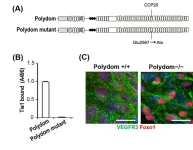(Press-News.org) In a new study, researchers from North Carolina State University detected elevated PFAS levels in the blood of pet dogs and horses from Gray’s Creek, N.C. – including dogs that only drank bottled water. The work establishes horses as an important sentinel species and is a step toward investigating connections between PFAS exposure and liver and kidney function in dogs and horses.
The study included 31 dogs and 32 horses from the community, and was conducted at the behest of community members concerned about their pets’ well-being. All of the households in the study were on well water, and all of the wells had been tested and deemed PFAS contaminated by state inspectors.
The animals received a general veterinary health check and had their blood serum screened for 33 different PFAS chemicals. These PFAS were chosen based on compounds that were present in the Cape Fear River basin and the availability of analytical standards.
From the targeted list of 33 PFAS of interest, researchers found 20 different PFAS in the animals. All of the animals in the study had at least one chemical detected in their blood serum, and over 50% of the dogs and horses had at least 12 of the 20 detected PFAS.
PFOS, a long-chain PFAS used for years in industrial and commercial products, had the highest concentrations in dog serum. The perfluorosulfonic acid PFHxS, a surfactant used in consumer products and firefighting foams, was detected in dogs, but not horses. Consistent with wells being the known contamination source, some ether-containing PFAS including HFPO-DA (colloquially known as GenX), were detected only in dogs and horses that drank well water.
In dogs who drank well water, median concentrations of two of the PFAS – PFOS and PFHxS –were similar to those of children in the Wilmington GenX exposure study, suggesting that pet dogs may serve as an important indicator of household PFAS. Dogs who drank bottled water, on the other hand, had different types of PFAS in their blood serum. However, 16 out of the 20 PFAS detected in this study were found in the dogs who drank bottled water.
Overall, horses had lower concentrations of PFAS than dogs, though the horses did show higher concentrations of Nafion byproduct 2 (NBP2), a byproduct of fluorochemical manufacturing. The finding suggests that contamination of the outdoor environment, potentially from deposition of the PFAS onto forage, contributed to their exposure.
“Horses have not previously been used to monitor PFAS exposure,” says Kylie Rock, postdoctoral researcher at NC State and first author of the work. “But they may provide critical information about routes of exposure from the outdoor environment when they reside in close proximity to known contamination sources.”
Finally, the veterinary blood chemistry panels for the animals showed changes in diagnostic biomarkers used to assess liver and kidney dysfunction, two organ systems that are primary targets of PFAS toxicity in humans.
“While the exposures that we found were generally low, we did see differences in concentration and composition for animals that live indoors versus outside,” says Scott Belcher, associate professor of biology at NC State and corresponding author of the work.
“The fact that some of the concentrations in dogs are similar to those in children reinforces the fact that dogs are important in-home sentinels for these contaminants,” Belcher says. “And the fact that PFAS is still present in animals that don’t drink well water points to other sources of contamination within homes, such as household dust or food.”
The work appears in Environmental Science and Technology and was supported by the National Institute of Environmental Health Sciences and the North Carolina Policy Collaboratory.
-peake-
Note to editors: An abstract follows.
“Domestic Dogs and Horses as Sentinels of Per- and Polyfluoroalkyl Substance (PFAS) Exposure and Associated Health Biomarkers in Gray’s Creek North Carolina”
DOI: 10.1021/acs.est.3c01146
Authors: Kylie D. Rock, Madison E. Polera, Hannah M. Starnes, Scott M Belcher, North Carolina State University; Theresa C. Guillette, Oak Ridge Institute for Science and Education Research Participation Program; Kentley Dean, Southern Oaks Animal Hospital; Mike Watters, Debra Stevens-Stewart, Gray’s Creek Residents United Against PFAS in Our Wells and Rivers
Published: June 21 in Environmental Science and Technology
Abstract:
Central North Carolina (NC) is highly contaminated with per- and polyfluoroalkyl substances (PFAS), in part due to local fluorochemical production. Little is known about the exposure profiles and long-term health impacts for humans and animals that live in nearby communities. In this study, serum PFAS concentrations were determined using liquid chromatography high-resolution mass spectrometry and diagnostic clinical chemistry endpoints were assessed for 31 dogs and 32 horses that reside in Gray’s Creek NC at households with documented PFAS contamination in their drinking water. PFAS were detected in every sample, with 12 of the 20 PFAS detected in ≥50% of samples from each species. Average total PFAS concentrations in horses were lower compared to dogs who had higher concentrations of PFOS (dogs 2.9 ng/ml; horses 1.8 ng/ml), PFHxS (dogs 1.43 ng/ml, horses <LOD), and PFOA (dogs 0.37 ng/ml; horses 0.10 ng/ml). Regression analysis highlighted alkaline phosphatase, glucose, and globulin proteins in dogs and gamma glutamyl transferase in horses as potential biomarkers associated with PFAS exposure. Overall, the results of this study support the utility of companion animal and livestock species as sentinels of PFAS exposure differences inside and outside of the home. As in humans, renal and hepatic health in domestic animals may be sensitive to long-term PFAS exposures.
END
PFAS found in blood of dogs, horses living near Fayetteville, NC
2023-06-21
ELSE PRESS RELEASES FROM THIS DATE:
Toward a better understanding of lymphatic system remodeling
2023-06-21
Osaka, Japan – Lymphangiogenesis refers to the formation and remodeling of lymphatic vessels (a network of thin tubes that carry lymph in the lymphatic system), and it supports the transport of molecules and immune cells around the body. Recently, a team led by researchers at Osaka University has uncovered important insights into lymphatic cell migration and lymphatic vessel remodeling.
Polydom (or SVEP1) is a kind of protein that is essential for making new lymphatic vessels; this is known because mice that do not express this protein have problems with lymphatic ...
KIMS redefined the role of the current collector!
2023-06-21
A research team led by Dr. Ji-Hoon Lee of the Department of Hydrogen Energy Material at the Korea Institute of Materials Science (KIMS) developed a three-dimensional porous carbon-based current collector material and applied it to secondary batteries and supercapacitors to improve energy density and lifespan at the same time with Prof. Insuk Choi at Seoul National University and Prof. Jungho Shin at Gangneung-Wonju National University. KIMS is a government-funded research institute under the Ministry of Science and ICT.
A current ...
Stark racial and ethnic disparities in alcohol-related US deaths during Covid, study reveals
2023-06-21
Alcohol-related deaths rose disproportionately quickly in the US among Black, Hispanic, Asian and American-Indian/Alaska Native populations at the start of the COVID-19 pandemic, new research shows.
Detailed in The American Journal of Drug and Alcohol Abuse, the peer-reviewed analysis of official data revealed that while the rate of deaths that can be directly attributed to alcohol increased sharply overall, there were stark ethnic and racial disparities.
“Racial and ethnic minority groups experienced disproportionately higher rates of unemployment, fear of Covid and financial strain during the pandemic,” says ...
One in five women become pregnant naturally after having a baby conceived with IVF
2023-06-21
Around 20% of women who needed fertility treatment, such as IVF, to conceive their first child are likely to get pregnant naturally in the future, finds a new UCL study.
The first-of-its-kind research, published in Human Reproduction, analysed data from 11 studies of over 5,000 women around the world between 1980 and 2021, to evaluate how common it is to get pregnant naturally after having a baby conceived by fertility treatment.
They found that at least one in five women conceived naturally after having had a baby using fertility treatment such as IVF mostly within 3 years. This figure remained unchanged, even when taking into account the different ...
Xylazine appears to worsen the life-threatening effects of opioids in rats
2023-06-21
A new study in rats suggests that xylazine, the active ingredient in a non-opioid veterinary tranquilizer not approved for human use, can worsen the life-threatening effects of opioids. The findings imply that when used in combination with opioid drugs such as fentanyl and heroin, xylazine may damage the ability of the brain to get enough oxygen, which is one of the most dangerous effects of opioid drugs and can lead to death. The study, published in Psychopharmacology, was led by researchers at the National Institute on Drug Abuse (NIDA), part of the National Institutes of Health.
Research has shown xylazine is ...
Antidepressants prescription associated with a lower risk of testing positive for COVID-19
2023-06-21
Press release: Under embargo until Wednesday 21 June 2023, 01.00 BST
New research led by the Institute of Psychiatry, Psychology & Neuroscience (IoPPN) at King’s College London has found that community mental health patients who were prescribed antidepressants were significantly less likely to test positive for COVID-19 when admitted to inpatient care.
The research, published in BMC Medicine, suggests that antidepressants – particularly the most commonly prescribed class called selective serotonin ...
ASPB welcomes new meetings and membership executive
2023-06-21
ROCKVILLE, MD - The American Society of Plant Biologists (ASPB) is pleased to welcome Jennifer Covington as the Society’s Vice President of Membership and Meetings, an exciting and critical role for the Society as it looks ahead to an evolving landscape for scientific meetings and society membership.
As Vice President of Membership and Meetings, Ms. Covington will oversee the development of revenue and results-oriented products and services in the membership, conference, and educational areas. Her responsibilities include the development of online and in-person conferences, workshops, and webinars; digital ...
The American Society of Plant Biologists names 2023 award recipients
2023-06-21
The American Society of Plant Biologists (ASPB) is pleased to announce the recipients of its 2023 awards, which honor distinction in service, outreach, education, and research.
ASPB Innovation Prize for Agricultural Technology
Renata Bolognesi, Stanislaw Flasinski, Sergey Ivashuta, Daniel Kendrick, Curtis Scherder, Gerrit Segers
Bayer, Chesterfield, Missouri
Charles Albert Shull Award
José Dinneny
Stanford University, Stanford, California
Charles Reid Barnes Life Membership Award
John Browse
Washington State University, Pullman
Natasha Raikhel
University of California, Riverside
Early Career Award
Moisés Expósito-Alonso
Carnegie Institute ...
THE LANCET CHILD & ADOLESCENT HEALTH: Prolonged rise in eating disorders and self-harm among adolescent girls in the UK following the COVID-19 pandemic, best evidence to date suggests
2023-06-21
The rate of eating disorder diagnoses among girls aged 13–16-years-old in the UK during the first two years of the COVID-19 pandemic (from March 2020–March 2022) was 42% higher than the expected rate based on previous trends, suggests a study published in The Lancet Child & Adolescent Health journal. The rate of self-harm diagnoses in the same cohort was 38% higher than the expected rate for the two-year period.
As the largest and most targeted nationwide study in the adolescent population, and the first to cover two years of the pandemic, these findings are the best available evidence on eating disorder and self-harm diagnoses among young ...
Screening newborns for deadly immune disease saves lives
2023-06-21
Introducing widespread screening of newborns for a deadly disease called severe combined immunodeficiency, or SCID, followed by early treatment boosted the five-year survival rate of children with the disorder from 73% before the advent of screening to 87% since, researchers report. Among children whose disease was suspected because of newborn screening rather than illness or family history, 92.5% survived five years or more after treatment. These findings demonstrate for the first time that newborn screening facilitated the early identification of infants with SCID, leading to prompt ...




